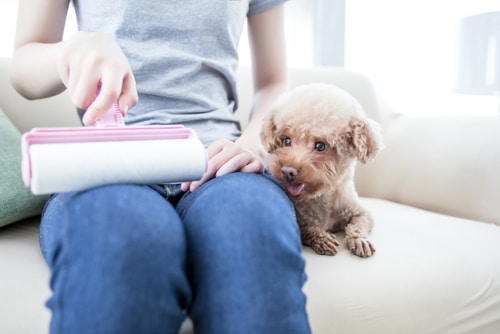Having a pet, therapy animal or Assistance Dog can be wonderful for day to day enjoyment. We’re big advocates of bringing a fur kid into your life if you have the means to care for it! However, a four pawed friend does mean flyaway fur on your furniture, floors and clothes. So what’s the best pet hair remover option for limited mobility?
Great question.
In this article, Blue Badge rounds up some simple ways to reduce and remove pet fur. We take into consideration how this might be made easier with limited mobility. Here’s what we’ve covered.
In this article
- The pet hair remover challenge with limited mobility
- Dogs that don’t shed
- Hypoallergenic dogs
- 1. Pet hair remover brush
- 2. Lint roller to remove cat and dog hair
- 3. Cat and dog grooming brush to reduce flyaway fur
- 4. Baking soda pet hair remover for carpets
- 5. Rubber glove – limited mobility or not
- 6. Vinegar as a pet hair remover for laundry
- Reducing hairy situations with Assistance Dog and pet insurance
The pet hair remover challenge with limited mobility
Animals are wonderful but not everyone loves the fur they shed. Some of us even have allergies. If you have a companion animal, therapy animal or Assistance Dog, even though you love them, you may not love the fur. We’re with you on that.
Before we get onto the ins and outs of what pet hair remover options best suit you, did you know some dogs don’t shed? Well – at least not all that much. This means less of an allergic reaction from those of us who have them. Find out more below…

Dogs that don’t shed
If you’re looking for a furry family member, you may be interested to know that not all dogs shed (as much as others). That’s because some dogs don’t have fur but instead have hair.
Dog fur grows all the time but also falls out all the time too once it reaches a certain length. The constant shedding means your clothing, floors and furniture will inevitably have loose fur clinging to them.
Hypoallergenic dogs
Hair on the other hand doesn’t shed all that much. Instead it can continuously grow and become really long. That’s more like humans whose hair only falls out in littler amounts. Dogs that have hair are considered to be hypoallergenic dogs.
This means fewer allergies and fewer bits of fur flying around and sticking to things. Dogs with hair won’t prevent allergies altogether as they still produce dander – dead skin that falls off – but because they don’t shed as much, they also shed less dander.
If you’re getting a hypoallergenic dog breed then dog hair remover options will still be useful but the need for them won’t be as great.
Now, let’s take a look at some great pet hair removal options.
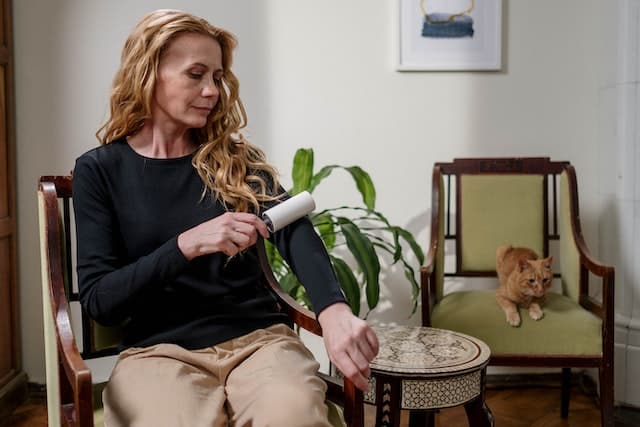
1. Pet hair remover brush
There are lots of pet hair remover brushes on the market across a broad range of prices. Unlike grooming brushes these are specially designed to remove pet hair from your furniture, carpets and clothing. Just take note when buying a pet hair remover brush as some are only for clothing, others are only for carpets, etc.
Look for brushes with rubber bristles or ones specifically labelled as pet hair removers. These brushes often have an ergonomic handle that can be easier to grip and use while seated in a wheelchair.
Here are some options:
2. Lint roller to remove cat and dog hair
A highly popular option for dog and cat hair removal is a lint roller. This adhesive roller is simply a wonder – just roll it over your furniture and clothes to pick up pet fur.
A good idea is to look for a lint roller with an extended handle or one that can be attached to a long pole, which will make it easier to reach different areas while seated in a wheelchair.
Here are some options to remove pet hair with lint rollers that have shorter, longer and extendable handles:
Conveniently you can replace the lint roll on most handles once the sticky roll is used up.
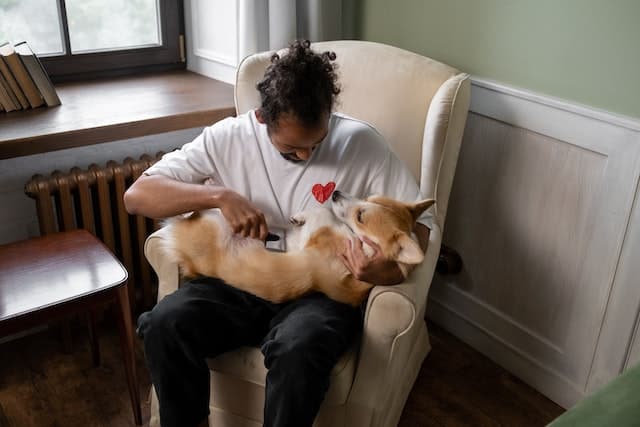
3. Cat and dog grooming brush to reduce flyaway fur
A great pet hair remover option is catching the fur before it falls from your dog or cat. Grooming brushes are often designed to detangle and remove loose fur. Not only this, but regular grooming gives you a chance to spend time bonding with your pet in a way that’s also useful for keeping a tidy home.
Take note that however tempted you may be to have your pet’s fur shaved this isn’t a good idea. It can cause imbalances in the skin and cause fur to grow back in an even harder to manage style. Read why a shaved dog is a bad idea and have a look at these cat and dog hair remover brushes for grooming:
4. Baking soda pet hair remover for carpets
Baking soda is a great DIY pet hair remover for fur that’s lying on the floor. If you have a carpeted floor, no doubt it’s catching all those loose hairs and trapping them fast. By sprinkling baking soda before the floor is vacuumed, you (or a carer or cleaner) will effectively be loosening the fur so it comes away more easily.
Once the baking powder is sprinkled, then we’re ready for phase two: bring out the vacuum!
For maximum effect use your brush attachment on the nozzle of your vacuum. Some vacuum cleaners even come with pet hair remover attachments for cleaning floors AND furniture. Look for lightweight, portable vacuum cleaners that are easier to manoeuvre with limited mobility or go with a robot vacuum.
Here are some vacuum cleaner options:
There’s even a vacuum to remove loose pet fur straight off pets!
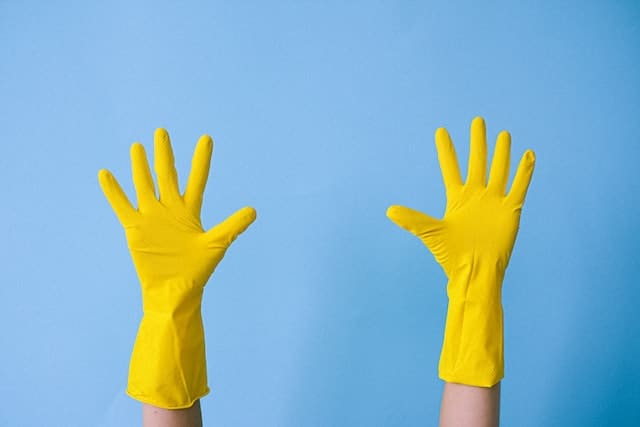
5. Rubber glove – limited mobility or not
It might seem obvious, but a rubber glove is a great pet hair remover. There are plenty of commercially available ones but you can also use a normal cleaning rubber glove. The rubber reduces the static electricity causing the fur to stick to surfaces and lifts it easily.
Here are some options that double up with one glove designed for grooming and the other for collecting fallen hair:
6. Vinegar as a pet hair remover for laundry
Pet hair has a tendency to cling to fabric because of static electricity. That’s why it holds fast to your clothing. Vinegar is routinely used to soften laundry (not straight, though – it needs to be diluted). By softening clothing it also helps reduce static cling, helping the fur fall off your clothing more easily during the drying process.
Of course, regular fabric softener will also do the trick. However both these options may not be enough on their own. Ideally you can use a lint roller to remove most of the pet fur before your laundry goes into the washing machine. After all, the more fur that goes into it the more often the washing machine lint trap will need cleaning.
Another pet hair remover option for laundry is a lint catcher. It’s a rubbery item that goes into the machine with your washing and the fur attaches to its tacky surface. The great thing about these is that they prevent the pet fur from clogging up your machine or staying on your clothes and they’re reusable! Win-win.
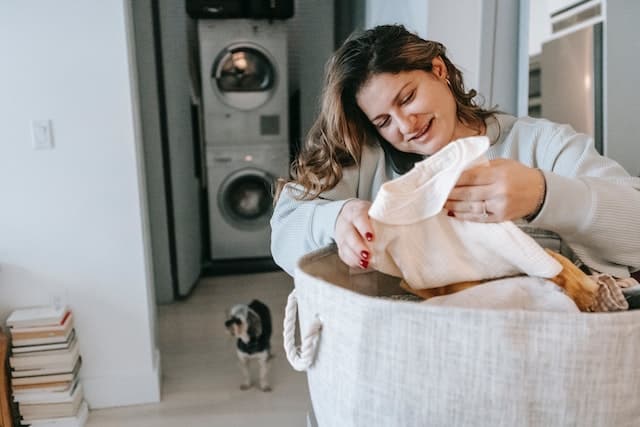
Reducing hairy situations with Assistance Dog and pet insurance
Now you know these pet hair remover tips, let’s talk about your pet, therapy animal or Assistance Dog. More specifically let’s talk about keeping them safe when they’re sick or injured by having a pet plan.
As Australia’s first disability and independence insurance specialist Blue Badge Insurance knows that pets help us lead happier, healthier lives. We also know that occasionally they need to go to the vet for unexpected accidents or illnesses. When that happens, having pet insurance can help you pay for medical costs.
Contact us today to start your pet’s plan and know that you can save 15% on pet insurance with a disability parking permit. You can also get up to 25% off our Assistance Dog Insurance. Click below today to get a quote.


